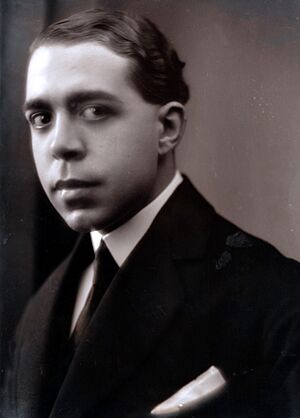Néstor Martín-Fernández de la Torre facts for kids
Néstor Martín-Fernández de la Torre, often called just Néstor, was a talented artist from the Canary Islands. He was born in Las Palmas on May 4, 1887, and passed away there on February 6, 1938. Néstor was famous for his paintings and for designing amazing sets and costumes for plays and ballets. His art style was a mix of Symbolism and Art Deco.
Contents
Biography
Early Life and Art Training
Néstor started learning art very young, at just seven years old. He went to "Colegio San Agustín" where Nicolás Massieu taught him drawing. Nicolás later became a famous painter himself. In 1899, Néstor received his first official art lessons. These came from Eliseu Meifrèn, a Spanish landscape painter who traveled a lot.
Studying Art in Madrid and Beyond
When Néstor was only fifteen, he received a special grant from Las Palmas. This money allowed him to study art in Madrid. He tried to get into the Royal Academy of Fine Arts. However, the entrance tests were too hard for him.
So, Néstor decided to teach himself. He spent time at the Museo del Prado, copying famous paintings. This helped him learn different art techniques. He eventually found a place in the art studio of Rafael Hidalgo de Caviedes.
Traveling and Learning
To improve his skills even more, Néstor traveled widely. He visited many big cities like Paris, Brussels, and London. While in Paris, he also started designing things for the theater. He created beautiful sets and costumes for plays.
First Exhibitions and Designs
In 1907, Néstor set up his own art studio in Barcelona. His first art show happened in 1908. It was at the "Círculo Ecuestre," a sports and social club. Here, he showed off a series of portraits. These paintings were influenced by his time spent in England.
The next year, he displayed four large decorative panels at the Sala Parés. He had designed these panels for a dance hall in Tibidabo. They were inspired by the poems of Jacinto Verdaguer.
Theatrical Design and Later Years
Néstor continued to show his art in many places. He had exhibitions in Paris, London, and Madrid. In 1915, he had his first big job as a theatrical designer. He created all the sets and costumes for a play called El amor brujo. This play was by Manuel de Falla and was performed in Madrid.
In 1928, Néstor moved his studios to Paris. He did even more design work there. He created costumes for famous performers like Cécile Sorel, Grace Moore, and Conchita Supervía. He designed for ballets, operas, and other stage shows.
After more travels, including trips through Spanish colonies in Africa, Néstor returned home. He opened a studio in Las Palmas in 1934. Besides his paintings, he decorated the "Casino de Tenerife" in Santa Cruz. He also decorated the "Teatro Pérez Galdós" in Las Palmas. Néstor started a campaign to encourage tourism. He called it "Tipismo," which means "picturesqueness."
Néstor passed away suddenly from pneumonia. He left several big art projects unfinished.
Néstor's Legacy: The Museo Néstor
In 1956, the "Museo Néstor" opened in Las Palmas. This museum is in the "Pueblo Canario," a cultural area. His brother, Miguel Martín-Fernández de la Torre, who was an architect, designed this complex. The "Pueblo Canario" includes decorations made by Néstor himself. The museum holds most of his amazing artworks.
See also
 In Spanish: Néstor Martín-Fernández de la Torre para niños
In Spanish: Néstor Martín-Fernández de la Torre para niños



